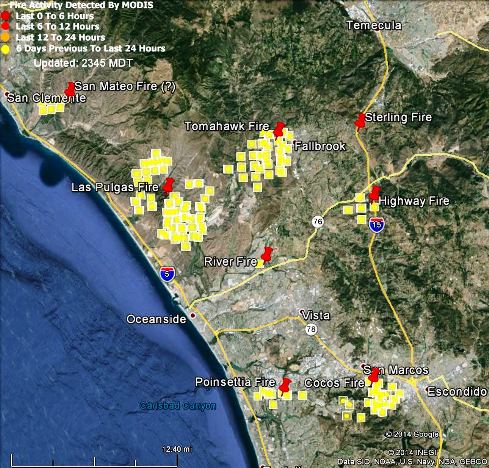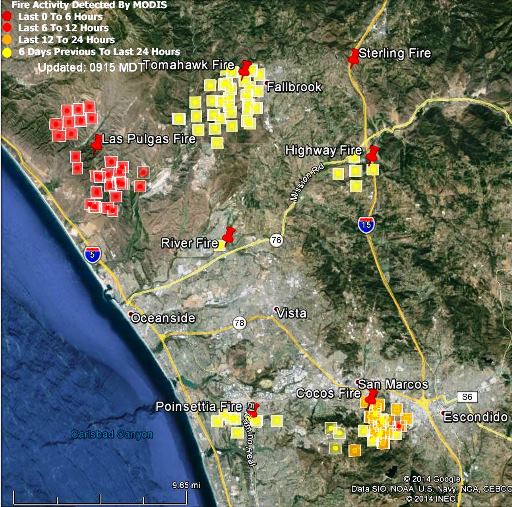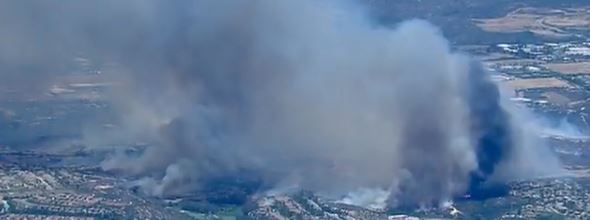Some firefighters from the Fresno Fire Department (California) had a little too much excitement while fighting fire at Camp Pendleton recently. As far as we know there were no injuries.
Tag: California
Update on San Diego County fires

(Originally published at 12:03 a.m. PDT, May 18, updated at 10:12 a.m. PDT, May 18, 2014)
Camp Pendleton Fires
The most recent fire to break out at Camp Pendleton has gone by three names, Combat Fire, Talega Fire, but the latest name is San Mateo Fire. It has burned 1,500 acres in the northwest corner of the base and is listed at 55 percent contained.
The Tomahawk Fire is listed at 6,500 acres with 93 percent containment. The Las Pulgas Fire has burned 15,000 acres and is 42 percent contained.
San Diego County reports that all evacuations have been lifted at Camp Pendleton.
Cocos Fire in San Marcos
The Cocos and Highway Fires are being managed as the San Diego Complex by a CAL FIRE Incident Management Team. CAL FIRE reports the Highway Fire is 100 percent contained at 380 acres, while the Cocos Fire has blackened 1,995 acres (it keeps shrinking), is 85 percent contained, and eight structures have burned.
Other fires in San Diego County
The Poinsettia and Bernardo Fires are 100 percent contained.
Amazing what a difference 24hrs makes…#CampPendletonFire #SanDiegoFire #CocosFire #SanMarcosFire #3rdMAW @USMCnews pic.twitter.com/nlL3DVTiYj
— MCAS Miramar, 3rdMAW (@MCASMiramarCA) May 18, 2014
More photos taken from military helicopters are at Fire Aviation.
Video: driving past a southern California wildfire
The description of the video does not specify the location, but it is most likely the Cocos Fire in San Marcos, California.
California: Las Pulgas Fire on Camp Pendleton

A new fire at Camp Pendleton in southern California grew rapidly after it started at 3:15 p.m. Thursday. A 5:09 a.m. update on Friday from the base said it had burned 8,000 acres and was 5 percent contained. Several areas on the base have been evacuated. Little other information about the fire is available, other than evacuation areas, since the Marines rarely allow reporters on the base when a fire is burning.
A total of 19 military helicopters are providing fire suppression support to firefighters in southern California, including eight Marine Corps CH-46 Sea Knight helicopters, seven CH-53 Sea Stallion helicopters and four UH-1Y Huey helicopters.
#wildfire #camppendleton #hmla #laspulgasfire #calfire #ch46 pic.twitter.com/qqBArb0ZDd
— Demetrios Marinides (@dmarinides) May 16, 2014
#Wildfire at Camp Pendleton across street from San Onofre, CA #nuclear plant. pic.twitter.com/xJBqXk7zgk — Beyond Nuclear (@BeyondNuclear) May 14, 2014
@ABCNewsLive @brandon_rosser and it’s all coming to Temecula…..??????
Deceased person found in Poinsettia Fire in Carlsbad, California

A deceased person has been found inside the perimeter of the Poinsettia Fire in Carlsbad, California.
The City announced today that during mopup of the 400-acre blaze, firefighters were alerted to a transient encampment in the area of Ambrosia and Calliandra. On checking the area, firefighters located a badly burned body. Further details about the deceased are unknown at this time and the investigation is ongoing. There have been no other reported injuries or fatalities.
Carlsbad is on the Pacific coast between Oceanside and San Diego. More information about the Poinsettia Fire which started May 14, 2014.
Video: Prescribed Burning in Northern California
This video provides a great deal of information about the use of prescribed fire in northern California. It is well done, with high production values.
The description on YouTube:
Catching Fire tells a compelling story of how a small but committed group of local, tribal, state and federal land managers are bringing back the use of prescribed fire as a tool to protect communities and ecosystems across Northern California. It examines the use of fire by the Karuk Tribe of California, and the connection between the rise of megafires across the West and the last century of fire suppression. Drawing on interviews with
fire scientists, tribal and federal land managers, and fire savvy residents from across the North State, this film provides insight on how our relationship to fire can be restored through strategic use of fire as a powerful management tool.Produced By: Will Harling and Jenny Staats, Orleans/Somes Bar Fire Safe Council,
Klamath-Salmon Media Collaborative
Narrration By: Peter Coyote
Music By: Rex RichardsonFunding Provided By: a USDA Forest Service National Fire Plan grant through the California Fire Safe Council
Additional Funding Provided By: The Watershed Center, The Fire Learning Network, The US Endowment for Forestry and Communities
Thanks and a hat tip go out to John.
